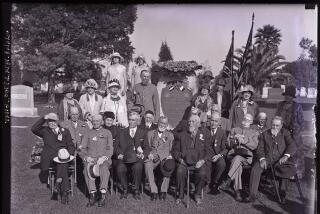Why America’s Bloodiest War Haunts Us Still
- Share via
It is a curious paradox of Civil War literature that although many subjects have been studied exhaustively, big themes are sometimes neglected. On first glance, David J. Eicher’s “The Longest Night” seems to belong to this tedious category. Eicher has written a straightforward narrative that places events in their correct sequence. Chapters with unambiguous headings such as “Grant Moves Into the Wilderness” also include the details of other events (for example, William Tecumseh Sherman’s advance on Atlanta in the spring of 1864), and Eicher focuses on every important battle and skirmish, suggesting that here, indeed, is another lackluster chronicle of the American War Between the States.
But on closer scrutiny, “The Longest Night” reveals something altogether more impressive: a command of the subject, including major themes, and a wealth of facts and figures. An associate editor of North and South magazine, Eicher displays a gift for writing about battles, which he outlines elegantly and clearly, and he also has succeeded in dispensing with sectional bias. A pro-Northern interpretation is advanced by Bruce Catton in his three-volume centennial history and elsewhere, while Southern partiality is evident in Shelby Foote’s “The Civil War: A Narrative.”
“I have attempted a different kind of work,” Eicher explains. He has written a narrative “that describes the strategy and tactics of the battles on land, sea, and river, with the focus on military operations throughout.” Drawing on sources not used by Catton and Foote, he stresses that he has “endeavored to make a story without embellishment.”
Eicher estimates that there were about 8,700 notable battles and skirmishes, including the frequently overlooked clashes in the Trans-Mississippi theater. In these years, whatever their background, most American generals thought in terms of fighting single decisive battles, not protracted campaigns. It is one of the neglected aspects of the Civil War that historians have not adequately explained this fascination, which is partly based on a legacy of nationalism that had aroused the United States in the first half of the 19th century (even while secessionist sentiment was stirring).
George Washington’s victories at Trenton and Yorktown, plus those of Horatio Gates at Saratoga, Andrew Jackson at New Orleans and Winfield Scott’s string of successes in the Mexican War (1846-48) became nationalistic symbols. They were romanticized, sometimes overpraised, and they conveyed the impression that victory was a relatively easy thing for any determined leader. The role of economic warfare, or the incremental action of attrition (wearing away slowly at the enemy’s strength), coupled with less glamorous action such as guerrilla warfare, was ignored by most who desired high command. Many an ambitious general, striking a Napoleonic pose for the camera, encouraged by florid newspaper stories, saw himself the emperor’s successor as a military genius.
The main dilemma facing Civil War commanders, however, was the discrepancy between this aspiration to match (if not exceed) Napoleon’s lightning campaigns and the actual result: a long list of frustrating, incomplete successes. They chose to ignore the fact that none of Napoleon’s great victories, even Austerlitz (1805), was decisive in bringing the Napoleonic Wars to a conclusion in France’s favor.
Eicher rightly points out that one of the greatest challenges posed by the Civil War was coming to terms with its massive escalation. In a passage redolent of post-Vietnam America, Eicher writes that in 1861, “virtually no one could see the grim horror of the magnitude of the death and waste to come. For all Americans, whether they knew it or not, it was the start of their longest night.” Such language is permeated by the imagery of darkness (which, via Joseph Conrad’s “Heart of Darkness” metamorphosed into “Apocalypse Now,” has become a synonym for Vietnam). It would have been alien to the post-World War II generation of Civil War historians (such as T. Harry Williams, Catton and Kenneth P. Williams), who thought of the war in more positive terms.
Yet a reluctance to comprehend the magnitude of the struggle was evident in 1861. Some conservative leaders could not believe that the South was in earnest in its desire to leave the Union. Once passions cooled, they hoped, Unionist sentiment would surely revive. In any case, doubts were expressed that any army could subdue an area as large as the Confederacy, which is why they pursued military strategies that would take time to work. These included a naval blockade and the aged general-in-chief Winfield Scott’s “Anaconda Plan,” designed to strangle the Confederacy in the Mississippi Valley by a systematic occupation of key points.
Public opinion, however, was too impatient to wait for these measures to work. The universal expectation was that the war should be ended with one big battle. After the transfer in May 1861 of the Confederate capital to Richmond, Va., Abraham Lincoln was anxious to launch an immediate attack toward it. The trouble was, as Eicher indicates, that rapid offensive action exerts greater pressure on military technique than a defensive stance. Even if Lincoln was right in assuring his first commander, Irvin McDowell, “You are all green alike,” the Union forces were taking the greater risk by attacking. The initial Union defeat at the First Battle of Bull Run that followed was not “decisive” in any Napoleonic sense. But it allowed the Confederacy to mortgage its existence for another year and therefore ensured that the war would continue.
For the North, it was a severe moral blow. Thereafter, Northern generals in the East invariably sought refuge by taking the cautious path. They were deluded into thinking (and Eicher unfortunately indulges this myth) that Southerners were the beneficiaries of a coherent Southern military tradition, when in reality Confederate commanders were no better prepared, intellectually and psychologically, than their Union counterparts.
The defeat at First Bull Run sponsored the careers of commanders, notably George B. McClellan and Don Carlos Buell, who believed that overwhelming success could be achieved only by laborious training, intricate preparation and the use of engineering methods. Battles fought on rebel terms should be avoided and casualties reduced by remaining on the defensive. However, this formula too often served as a pretext for not making a decision. McClellan bequeathed to the Army of the Potomac a defensive outlook that it did not slough off until 1865, when Ulysses S. Grant infused it with his own determination to win the war at the earliest opportunity.
McClellan was temperamentally incapable of bringing the Civil War to an end in 1862, although the portents were propitious. The Union had won a series of victories in the spring, including Shiloh, and the cities of Nashville and New Orleans had been taken. McClellan advanced sluggishly on Richmond from the east along the peninsula between the York and James rivers. Once attacked vigorously by Robert E. Lee, McClellan surrendered the initiative and retreated.
Two months later, at Antietam, McClellan was offered the priceless opportunity to win the decisive victory that could have fatally wounded the Confederacy. He failed, however, to grasp that plans do not run themselves. His army was poorly deployed and insufficiently concentrated, and its power was frittered away in a series of piecemeal attacks. Eicher sums up McClellan fairly but harshly: He was the antithesis of the Napoleonic general, “more of a spectator than a commanding general.”
Decisive battles demand men of decision to win them. The South seemed to breed such men. Lee advanced into Maryland after winning Second Bull Run in 1862. Confederate Gen. Braxton Bragg, in an audacious move, transferred his army from Northern Mississippi to Kentucky (although his nerve, too, would fail at the vital moment). The Confederates, claims Eicher, “took the initiative because ... the situation was desperate enough to require it.” These bold Confederate thrusts were met by cautious Union responses. They were driven back but not destroyed.
The year 1862 was crucial in shaping the pattern of the Civil War for it saw a string of great, inconclusive battles. This expansion of the war meant that it could not be ended suddenly by a lightning campaign but only by an aggregate of military force that would grind down the South. In any straight competition of industrial resources and manpower, the South could not win. The greater the deployment of Union armed strength, the more severe the dislocation of the South’s domestic institutions. The Civil War became a war to destroy slavery because the South’s “peculiar institution” underwrote its war economy. McClellan and Buell (a slaveholder) deplored these developments, but they had dismally failed to make the necessary decisions that would have resulted in keeping the war limited.
If Eicher’s detailed account has a weakness, it results from his focus on the battlefield. He neglects to consider the relationship between the conduct of the war and politics (usually party politics) in shaping strategy and endorsing more destructive methods. These were pioneered in the West in 1863, especially during Grant’s Vicksburg campaign and Sherman’s destructive march across northern Mississippi from Vicksburg to Meridian.
The great campaigns designed to end the war were commanded by this brace of successful generals from the West. Appointed general-in-chief in March 1864, Grant could dispose of 611,250 men “present” for duty, although a further 249,487 were identified as “absent.” It is curious that, notwithstanding Eicher’s pessimistic tone (for he believes that “[t]he year 1864 witnessed the darkest hour of America’s national nightmare”), he does not explore the roots of these very high levels of desertion.
In the East, Grant could deploy 118,700 men against Lee’s Army of Northern Virginia that numbered about 64,000 men. Grant expected to win, that is, to destroy Lee’s army and occupy Richmond by June 1864. Grant did eventually arrive in the environs of Richmond in June, but the war lasted another 10 months. Atlanta did not fall to Sherman until September. Why were these battles so prolonged and indecisive?
There are several answers. Civil War armies did exhibit structural weaknesses. There were far too many commands, which diluted the Union’s numerical superiority. These commands were often created as rewards for “political generals” (those who owed their rank to political influence), and Grant could not abolish them only seven months before Lincoln hoped to be reelected.
A second reason has enjoyed a great deal of attention from historians: the ascendancy of the defensive. The potency of the rifled musket and the widespread use of entrenchments (mainly breastworks) and abatis (barricades of branches, spikes and thorns) transformed all battlefields into formidable obstacle courses, placing attackers at a great disadvantage. Artillery also added support to the defensive because solid shot was ineffective against field fortifications but, when supplemented by canister or metal pellets, it was devastating against attacking infantry.
But opportunities for a tremendous, decisive success nonetheless did occur in the spring of 1864. Grant at Spotsylvania (twice) and, after the Crossing of the James, Sherman at Snake Creek Gap and Resaca could have destroyed the armies opposing them. In 1863, there was an increase in what are called “encounter battles,” when armies collide as a result of sides remaining ignorant of each other’s movements. This tendency was repeated in 1864 and arose from intelligence failures primarily caused by the misuse of cavalry. Too often cavalry were dispatched on dubious raids on enemy channels of communication, raids that were no substitute for intelligence-gathering. A dearth of intelligence meant that Union commanders had to guess what was in front of them. They were unprepared to exploit success, and by the time they did, Confederate commanders had either taken countermeasures or withdrawn.
The result was a relentless series of battles that wore away Confederate fighting power. Grant always expected something more but had to be content with the siege of Petersburg. The strategic significance of the latter has probably been exaggerated. It was not Grant pinning Lee at Petersburg that allowed Sherman to make his famous marches through Georgia and the Carolinas unmolested. John B. Hood made this possible by uncovering the Deep South after his quixotic (and insubordinate) decision to advance with the Army of Tennessee westward toward Nashville.
Winning decisive victories became easier for commanders at this latter stage of the Civil War. In December 1864, the Army of Tennessee was destroyed by George H. Thomas at the Battle of Nashville, partly because of a skillful use of cavalry. And likewise, once Grant had forced Lee out of Petersburg in April 1865, he could fight him in the open as he had planned to do since May 1864. With Philip H. Sheridan’s cavalry in his vanguard, Grant was able to pursue and envelop the Army of Northern Virginia and force capitulation in the field.
The Civil War ended in 1865 in the fashion that most had expected in 1861, or at the latest 1862--with cataclysmic action. But if the war had ended in 1861-62 without the suffering, death and sacrifice lamented by Eicher in “The Longest Night,” the South would have returned to the Union with slavery intact. Perhaps it would have taken a second civil war of even greater ferocity to destroy it.
More to Read
Sign up for our Book Club newsletter
Get the latest news, events and more from the Los Angeles Times Book Club, and help us get L.A. reading and talking.
You may occasionally receive promotional content from the Los Angeles Times.






